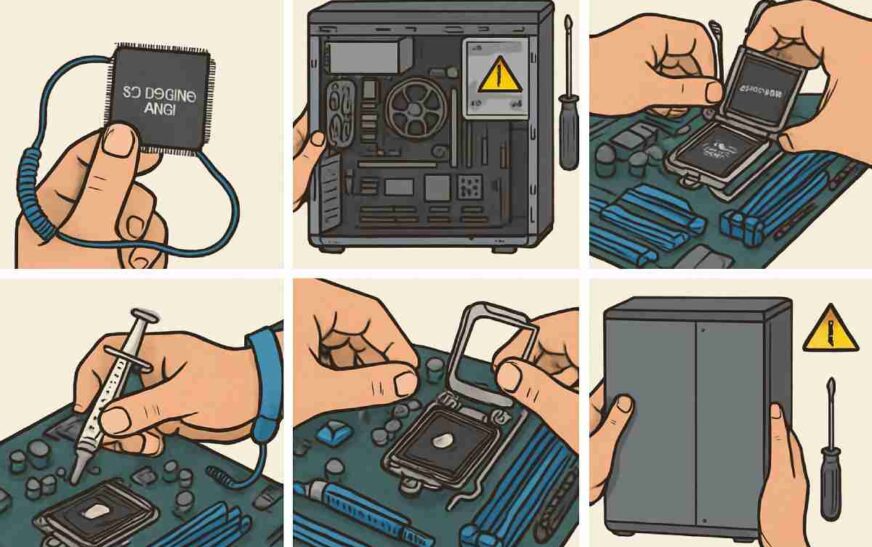Ever sat staring at your sluggish device, wondering if it’s worth cracking open the case for a speed boost? Or maybe you’re sweating over the idea of installing a piece like the 35-ds3chipdus3—because, yeah, chips and pins sound intimidating. But guess what? If you can wield a screwdriver and follow a checklist, you can absolutely install this chip. Let’s talk real: Outdated hardware slows you down, but shelling out for a new gadget is tough. Upgrading with the 35-ds3chipdus3 is where the magic happens—it’s affordable, practical, and totally doable even if your tech skills top out at “turn it off and on again”.
Why Everyone’s Curious About How to Install 35-DS3CHIPDUS3
Honestly, people just want to squeeze more life (and speed) out of their gear. Here’s why you’re in the right place:
- Faster boot and load times (We’re all sick of the spinning wheel.)
- Better energy efficiency (Less heat, more chill.)
- Do-it-yourself savings (Who needs a pricey upgrade when a chip will do?)
- Future-proofing (Run new software without lags or tears.)
What Even Is 35-DS3CHIPDUS3? (Skip if You’re Already a Fan)
It’s a compact little powerhouse—think of it as a shot of adrenaline for your motherboard. Great for computers, gaming rigs, and devices that feel like they’re stuck in 2012. I always tell friends: give your machine some love before chucking it on eBay—this chip’s ideal for just that.
Prepping for Installation (Or: How Not to Panic)
Before you dive in, get these basics lined up:
- Matching motherboard (Not all slots are the same!)
- Precision screwdriver set (No butter knives, please.)
- Anti-static wrist strap (Static’s sneaky. Protect your chip.)
- Thermal paste (For optimal cooling. If unsure, grab a fresh tube.)
- User manual (Trust me, keep it close.)
- Firmware update on USB (Some versions demand it—check those release notes.)
- A clean, clutter-free work area (Less clutter, less stress.)
Sprinkle in some patience—everyone messes up their first install. I’ve dropped screws inside cases before; it happens!
Step-by-Step: How to Install 35-DS3CHIPDUS3
Ready? Here’s my “coffee over the shoulder” checklist to get you through:
1. Power Down, Unplug, and De-Clutter
- Shut down. Unplug everything. No “I’ll just leave it plugged in…” Trust me!
- Remove external devices (USBs, speakers, etc.).
2. Open the Case—Keep Those Screws Safe!
- Use your screwdriver, pop the cover, and stash the (tiny) screws in a tray or mug.
- Lay the device flat—nobody wants a gravity-fueled disaster mid-install.
3. Ground Yourself/Protect the Chip
- Clip on that anti-static wrist strap. Better safe than frying the chip.
4. Know Which Version You’ve Got
- Check the sticker or the included docs—different versions (v1.0.0, v1.5.2, v2.0.0) have their own quirks. Some need a firmware update before you plug them in.
5. Find the Slot—Don’t Guess
- Your manual is your best pal. Most slots are labeled, usually beside the processor or memory.
- Brush away dust (gently!).
6. Remove the Existing Chip (If Needed)
- Unlock clips/screws on the old chip. Slide it out; never yank.
7. Align and Insert the 35-ds3chipdus3
- Line up notches—this is all about finesse, not muscle.
- Gently press down till you hear a click or hit resistance. Never jam!
8. (Optional) Apply Thermal Paste
- If your chip needs a heatsink, apply a pea-sized dot of thermal paste. Smooth it out for even coverage.
9. Secure Everything and Close Up
- Lock in the chip (clips/screws). Replace the case. Tighten screws but don’t overdo it—you want to open it again someday, right?
10. Power On and Watch Closely
- Plug in. Switch on. Watch and listen: any weird noises or error lights? If it boots, you’re golden!
Post-Installation To-Dos
Your hardware’s in—now wrap up like a pro:
- Install latest drivers from the manufacturer (this gets overlooked a lot—don’t skip it!)
- Run a system benchmark (try Geekbench or CPU-Z) to see just how much faster you’ve gotten.
- Monitor temps and performance—especially the first week. If fans go wild or heating spikes, check your install.
Troubleshooting—Because Stuff Happens
If you hit a snag, here’s my go-to quick fixes:
| Problem | Fix |
|---|---|
| Device won’t start | Reseat chip, check connections, redo steps |
| Performance is still sluggish | Double-check driver installs and updates |
| Overheating | Clean fans, ensure heat sink contact |
| Not detected by system | Check slot, update firmware/drivers |
| System freezes | Try reinstallation, check compatibility |
Maintenance—Don’t Set and Forget
Here’s how to keep things humming along:
- Update drivers monthly
- Clean out dust (compressed air, every 2 months)
- Run benchmarks each quarter—catch issues early
- Scan for malware (less load = longer device life)
Real Stories: Why I’d Recommend Installing the 35-ds3chipdus3
I’ve upgraded three old desktops and a gaming console with this chip. Each one turned from laggy to lively. My old work PC? What was once a coffee-fetching boot time now gets through startup before I get to my chair.
One More Thing—Feeling Nervous Is Normal
If you’re reading this just to psych yourself up: nearly everyone (including me!) worries about cracking open their first system. But if you prep right, follow each step, and stay patient, you’ll join the ranks who say, “Should’ve done this sooner!” Every step in how to install 35-ds3chipdus3 becomes easier the second time around. And remember, you’re not alone—there’s always a buddy (like yours truly!) or a community online to help if you get stuck.
So, if you’re ready for faster load times, cooler temps, and fresh life in your device, learning how to install 35-ds3chipdus3 is the upgrade that makes you wonder why you waited.
And yes—I fit the keyword in this last line too. Go rock your install!
Also Read: The Benefits of HR Outsourcing for Compliance and Risk Management




